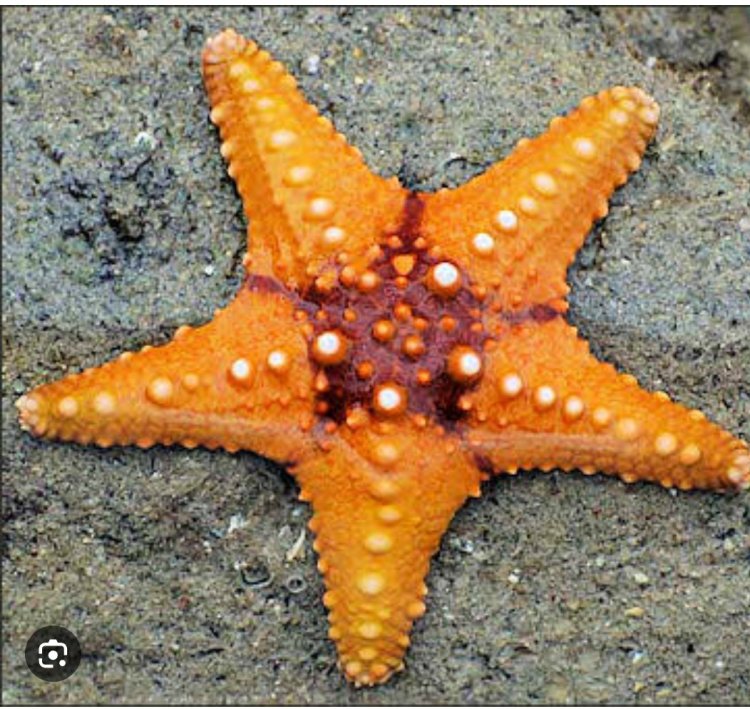The Echinoderms of sea
Starfish are among fascinating creatures of the ocean despite their name,they are not fish at all

Starfish.
Natures spiny marvels.
Starfish, also known as sea stars, are some of the ocean’s most fascinating creatures. With their symmetrical beauty, incredible regeneration abilities, and alien-like biology, they capture the imagination of scientists and beachcombers alike. Despite their name, starfish are not fish at all—they are echinoderms, a group that also includes sea urchins, sand dollars, and sea cucumbers.
Physical Characteristics
Most starfish have five arms, but some species can have as many as 40 arms. Their bodies are radially symmetrical, meaning their body parts are arranged around a central axis. Instead of a skeleton made of bone, they have a rigid calcareous endoskeleton covered with a tough, spiny skin.
Starfish move using a remarkable water vascular system. Instead of muscles alone, they pump seawater into tiny tube feet located under each arm. These tube feet not only help with movement but also grip surfaces so strongly that starfish can pry open the shells of prey.
Feeding Habits
Starfish are primarily carnivorous and love to feast on bivalves like clams and mussels. Their feeding method is as fascinating as it is unusual: they can evert their stomachs—pushing them outside their body—to digest food externally before pulling the stomach back inside. This allows them to eat prey larger than their mouths.
Regeneration: Nature’s Superpower
One of the most famous starfish abilities is regeneration. If they lose an arm, they can grow it back over time. Some species can regenerate an entire body from just one arm and part of the central disc, making them resilient survivors. This ability also helps them evade predators—if caught, they can sacrifice an arm to escape.
Fun Facts About Starfish.
1. They’re not fish at all
Despite the name, starfish don’t have gills, fins, or scales. They’re actually echinoderms—relatives of sea urchins and sand dollars.
Think of it like calling a jellyfish a “fish” — it’s just a nickname that stuck.
2. They have no brain… but they’re not clueless
Starfish have no central brain. Instead, they use a nerve ring around their body and nerve cords in each arm to coordinate movement and sensing.
It’s like running a group project with no leader—yet somehow, they manage just fine.
3. They pump seawater instead of blood
Instead of blood, they use a water vascular system—literally pumping seawater through their bodies. This powers their tube feet for walking and feeding.
They’re basically running on ocean juice.
4. They eat with their stomachs… outside their body
When a starfish finds a clam or mussel, it uses its strong tube feet to pry the shell slightly open. Then it pushes its stomach out of its mouth, slips it inside the shell, digests the food, and pulls the stomach back in.
It’s the ocean’s weirdest dinner party trick.
5. They can regrow lost arms
If a starfish loses an arm to a predator, it can regenerate a new one over months or years.
Some species can regrow an entire new body from a single arm and part of the central disc—like growing a whole new you from just your hand.
6. They can have way more than five arms
While the classic starfish shape has five arms, some species—like the sun star—can have up to 40 arms.
That’s a lot of high-fives.
7. They can live for decades
Some species can survive up to 35 years in the wild if left undisturbed.
In starfish years, that’s like being a wise old sea wizard.
8. They see with their arms
At the tip of each arm is a tiny eye spot—not for detailed vision, but for detecting light and movement.
It’s like having a security camera at the end of every limb.
9. They “smell” with their feet
The tube feet have sensory cells that detect chemicals in the water, helping them find prey.
Basically, they walk around tasting the ocean.
10. They’re vital to ocean health
Some species, like the ochre sea star, are keystone species—their presence keeps other populations (like mussels) in check. Without them, the ecosystem could collapse.
So, they’re not just pretty—they’re underwater ecosystem manager.
Role in the Ecosystem
Starfish play an important role in marine food chains. As predators of mussels, barnacles, and other shellfish, they help maintain biodiversity in intertidal zones. Without them, certain prey species could overpopulate and damage the ecosystem.
Threats and Conservation
Although starfish populations are generally stable, some face threats from pollution, habitat destruction, and sea star wasting disease—a mysterious illness that can decimate populations. Conservation efforts focus on protecting marine habitats and monitoring starfish health.
Conclusion
Starfish are more than just beautiful ocean residents—they are living examples of nature’s adaptability and resilience. With their alien-like biology, unusual feeding strategies, and super-regenerative powers, they remain one of the most captivating creatures of the sea. Next time you spot one along the shore, you’ll know you’re looking at an animal that’s both ancient and extraordinary.













